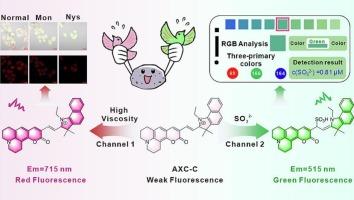近红外探针的量子化学引导设计,用于同时监测凋亡细胞中线粒体的SO₂衍生物和粘度。
IF 4.7
2区 医学
Q1 BIOCHEMISTRY & MOLECULAR BIOLOGY
引用次数: 0
摘要
细胞二氧化硫水平和黏度显著影响细胞功能,尤其是细胞凋亡,因此需要通过荧光成像进行实时监测。然而,能够同时跟踪细胞凋亡过程中这些动态变化的近红外荧光探针很少。在这项研究中,我们介绍了AXC-C,一种多功能近红外荧光探针,利用密度泛函理论(DFT)方法设计,用于监测凋亡细胞线粒体中的二氧化硫衍生物和粘度。我们发现AXC-C通过不同的发射通道区分二氧化硫和粘度,表现出高选择性和灵敏度。激发态计算证实,扭曲分子内电荷转移(TICT)过程控制其粘度响应。同时,通过观察静电势和局部电子亲和能,确定了二氧化硫的相互作用位点。AXC-C通过有效地观察细胞凋亡过程中线粒体粘度变化和二氧化硫的产生,证明了其多功能性,使其成为多功能检测平台。此外,基于智能手机的比色分析能够对真实食品样品进行快速、精确和经济高效的二氧化硫检测,为环境和食品安全应用提供实用的解决方案。这项研究强调了量子化学策略如何能够彻底改变荧光探针的设计,为实时细胞成像和实用检测平台提供新的途径。本文章由计算机程序翻译,如有差异,请以英文原文为准。

Quantum chemical-guided design of a near-infrared probe for simultaneous monitoring of SO₂ derivatives and viscosity for mitochondrial in apoptotic cells
The cellular sulfur dioxide levels and viscosity significantly affect cellular functions, especially apoptosis, driving the need for real-time monitoring via fluorescence imaging. However, near-infrared fluorescence probes capable of simultaneously tracking these dynamic changes during apoptosis are rare. In this study, we introduce AXC-C, a versatile near-infrared fluorescent probe designed using density functional theory (DFT) approaches to monitor sulfur dioxide derivatives and viscosity in the mitochondria of apoptotic cells. We showed that AXC-C distinguishes between sulfur dioxide and viscosity through distinct emission channels, exhibiting high selectivity and sensitivity. Excited-state calculations confirmed that the twisted intramolecular charge transfer (TICT) process governs its viscosity response. At the same time, observations of electrostatic potential and local electron affinity energy identified the sulfur dioxide interaction site. AXC-C demonstrated versatility by effectively visualizing mitochondrial viscosity changes and sulfur dioxide generation during apoptosis, establishing it as a multifunctional detection platform. Additionally, smartphone-based colorimetric analysis enabled rapid, precise, and cost-effective sulfur dioxide detection in real food samples, offering practical solutions for environmental and food safety applications. This study highlights how quantum chemical strategies can revolutionize fluorescent probe design, offering new avenues for real-time cellular imaging and practical detection platforms.
求助全文
通过发布文献求助,成功后即可免费获取论文全文。
去求助
来源期刊

Bioorganic Chemistry
生物-生化与分子生物学
CiteScore
9.70
自引率
3.90%
发文量
679
审稿时长
31 days
期刊介绍:
Bioorganic Chemistry publishes research that addresses biological questions at the molecular level, using organic chemistry and principles of physical organic chemistry. The scope of the journal covers a range of topics at the organic chemistry-biology interface, including: enzyme catalysis, biotransformation and enzyme inhibition; nucleic acids chemistry; medicinal chemistry; natural product chemistry, natural product synthesis and natural product biosynthesis; antimicrobial agents; lipid and peptide chemistry; biophysical chemistry; biological probes; bio-orthogonal chemistry and biomimetic chemistry.
For manuscripts dealing with synthetic bioactive compounds, the Journal requires that the molecular target of the compounds described must be known, and must be demonstrated experimentally in the manuscript. For studies involving natural products, if the molecular target is unknown, some data beyond simple cell-based toxicity studies to provide insight into the mechanism of action is required. Studies supported by molecular docking are welcome, but must be supported by experimental data. The Journal does not consider manuscripts that are purely theoretical or computational in nature.
The Journal publishes regular articles, short communications and reviews. Reviews are normally invited by Editors or Editorial Board members. Authors of unsolicited reviews should first contact an Editor or Editorial Board member to determine whether the proposed article is within the scope of the Journal.
 求助内容:
求助内容: 应助结果提醒方式:
应助结果提醒方式:


